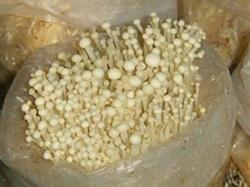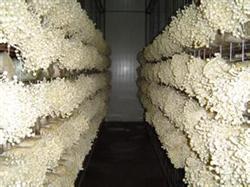Pollution-free high-quality cultivation of Flammulina velutipes

Flammulina velutipes can be planted in bag, bottle and bed, but most of them are planted in bag because of its high yield, short cycle and low cost, which is suitable for farmers. How to achieve pollution-free cultivation of Flammulina velutipes planted in bags? first, reasonably arrange the production season of Flammulina velutipes, which is resistant to cold and afraid of heat, and belongs to low-temperature fruiting mushrooms. The optimum temperature for mycelium growth is 3-34 ℃, and that for fruiting body is 5-20 ℃. Generally, the seeds can be cultivated from September to October, and mushrooms can be produced in the middle of November. If you take into account the large consumption of New Year's Day, the Spring Festival listing, the cultivation time can be postponed appropriately. Second, prepare as early as possible for cultivation materials such as cottonseed husk, straw or sawdust. In addition to the main ingredients, there are also auxiliary materials such as wheat bran, rice bran or cornmeal, in addition, calcium carbonate or gypsum powder and sugar are also needed. The general main materials are about 80%, excipients are about 15%, gypsum powder or calcium carbonate is 1%, and sugar is 1%. The main material can be pre-wet with water, the sugar can be dissolved in water and added to the main material, and then the excipients will be added and mixed well the next day. Flammulina velutipes is suitable for acidic medium and generally does not need to add lime or lime water. The commonly used cultivation strains of Flammulina velutipes are divided into two categories, one is light yellow to golden yellow Flammulina velutipes, such as hybrid 19, and the other is white Flammulina velutipes, such as Platinum No. 5, No. 6 and so on. Yellow Flammulina velutipes has the advantages of wide temperature range, strong adaptability, fast mushroom production and high yield. White Flammulina velutipes produces mushrooms slowly, its disease resistance is not as good as yellow Flammulina velutipes, and it is not suitable for cultivation in areas with high temperature and season. In addition, it is necessary to make preparations for mushroom houses, sterilization pans, cultivation bags, insecticidal and sterilization equipment, etc.: third, sterilization and inoculation culture bags can choose ethylene or propylene bags with a length of 35 cm and a width of 14 cm. Each bag contains 400g to 500g, the mouth of the bag and all around should be pressed tightly, and the upper part of the bag should have a space of about 18cm, so that Flammulina velutipes can grow and grow in the future. After loading the material, tie the head tightly, put it in the atmospheric pressure sterilization pot, sterilize for 10 hours and inoculate in the pot, pay attention to disinfection in the inoculation room, especially achieve no miscellaneous bacteria inoculation when using open inoculation. 4. 2-3 days after timely harvest and inoculation, the hyphae began to germinate, the food spread in 7-8 days, and the hyphae could grow full in about 40 days. Bacteria bags covered with mycelium can not only be moved to the cultivation room, but also be discharged underground or on the grid. Open the mouth of the bag and you can produce mushrooms. Moisture is easy to evaporate after the mouth of the bag is opened, so you should pay attention to moisturizing. Flammulina velutipes can be harvested when the mushroom grows to 15 cm high and the lid is not opened. Attention should be paid to scratching mushrooms and promoting mushrooms after harvest.
- Prev

Measures to promote mycelium growth of Pleurotus ostreatus in spring
Flammulina velutipes has crisp and tender meat, delicious taste, good taste, rich nutrition and good medical and health care. Flammulina velutipes is generally planted in autumn and winter, but less in summer. The Agriculture Bureau of Central District of Zaozhuang City used cold storage to control temperature to cultivate Flammulina velutipes in summer, and achieved success.
- Next

Introduction to soil culture and hydroponic culture of Phyllostachys pubescens
Fugui bamboo is native to Cameroon in western Africa. It is a perennial evergreen herb of the family Liliaceae. It is mainly used as a potted ornamental plant with high ornamental value and symbolizes good luck. The following editor will introduce the breeding methods and matters needing attention of Fugui bamboo.
Related
- Fuxing push coffee new agricultural production and marketing class: lack of small-scale processing plants
- Jujube rice field leisure farm deep ploughing Yilan for five years to create a space for organic food and play
- Nongyu Farm-A trial of organic papaya for brave women with advanced technology
- Four points for attention in the prevention and control of diseases and insect pests of edible fungi
- How to add nutrient solution to Edible Fungi
- Is there any good way to control edible fungus mites?
- Open Inoculation Technology of Edible Fungi
- Is there any clever way to use fertilizer for edible fungus in winter?
- What agents are used to kill the pathogens of edible fungi in the mushroom shed?
- Rapid drying of Edible Fungi

